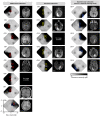Functional preservation and enhanced capacity for visual restoration in subacute occipital stroke
- PMID: 32428211
- PMCID: PMC7296857
- DOI: 10.1093/brain/awaa128
Functional preservation and enhanced capacity for visual restoration in subacute occipital stroke
Abstract
Stroke damage to the primary visual cortex (V1) causes a loss of vision known as hemianopia or cortically-induced blindness. While perimetric visual field improvements can occur spontaneously in the first few months post-stroke, by 6 months post-stroke, the deficit is considered chronic and permanent. Despite evidence from sensorimotor stroke showing that early injury responses heighten neuroplastic potential, to date, visual rehabilitation research has focused on patients with chronic cortically-induced blindness. Consequently, little is known about the functional properties of the post-stroke visual system in the subacute period, nor do we know if these properties can be harnessed to enhance visual recovery. Here, for the first time, we show that 'conscious' visual discrimination abilities are often preserved inside subacute, perimetrically-defined blind fields, but they disappear by ∼6 months post-stroke. Complementing this discovery, we now show that training initiated subacutely can recover global motion discrimination and integration, as well as luminance detection perimetry, just as it does in chronic cortically-induced blindness. However, subacute recovery was attained six times faster; it also generalized to deeper, untrained regions of the blind field, and to other (untrained) aspects of motion perception, preventing their degradation upon reaching the chronic period. In contrast, untrained subacutes exhibited spontaneous improvements in luminance detection perimetry, but spontaneous recovery of motion discriminations was never observed. Thus, in cortically-induced blindness, the early post-stroke period appears characterized by gradual-rather than sudden-loss of visual processing. Subacute training stops this degradation, and is far more efficient at eliciting recovery than identical training in the chronic period. Finally, spontaneous visual improvements in subacutes were restricted to luminance detection; discrimination abilities only recovered following deliberate training. Our findings suggest that after V1 damage, rather than waiting for vision to stabilize, early training interventions may be key to maximize the system's potential for recovery.
Keywords: hemianopia; perceptual learning; rehabilitation; training; vision.
© The Author(s) (2020). Published by Oxford University Press on behalf of the Guarantors of Brain. All rights reserved. For permissions, please email: journals.permissions@oup.com.
Figures







Similar articles
-
Spared perilesional V1 activity underlies training-induced recovery of luminance detection sensitivity in cortically-blind patients.Nat Commun. 2021 Oct 20;12(1):6102. doi: 10.1038/s41467-021-26345-1. Nat Commun. 2021. PMID: 34671032 Free PMC article.
-
Visual discrimination training improves Humphrey perimetry in chronic cortically induced blindness.Neurology. 2017 May 9;88(19):1856-1864. doi: 10.1212/WNL.0000000000003921. Epub 2017 Apr 12. Neurology. 2017. PMID: 28404802 Free PMC article.
-
Rehabilitation of visual perception in cortical blindness.Handb Clin Neurol. 2022;184:357-373. doi: 10.1016/B978-0-12-819410-2.00030-8. Handb Clin Neurol. 2022. PMID: 35034749 Free PMC article. Review.
-
Beyond blindsight: properties of visual relearning in cortically blind fields.J Neurosci. 2014 Aug 27;34(35):11652-64. doi: 10.1523/JNEUROSCI.1076-14.2014. J Neurosci. 2014. PMID: 25164661 Free PMC article.
-
New approaches to visual rehabilitation for cortical blindness: outcomes and putative mechanisms.Neuroscientist. 2010 Aug;16(4):374-87. doi: 10.1177/1073858409356112. Epub 2010 Jan 25. Neuroscientist. 2010. PMID: 20103505 Review.
Cited by
-
Visual Motion Coherence Responses in Human Visual Cortex.Front Neurosci. 2022 Mar 2;16:719250. doi: 10.3389/fnins.2022.719250. eCollection 2022. Front Neurosci. 2022. PMID: 35310109 Free PMC article.
-
Digital therapeutics using virtual reality-based visual perceptual learning for visual field defects in stroke: A double-blind randomized trial.Brain Behav. 2024 May;14(5):e3525. doi: 10.1002/brb3.3525. Brain Behav. 2024. PMID: 38773793 Free PMC article. Clinical Trial.
-
Spared perilesional V1 activity underlies training-induced recovery of luminance detection sensitivity in cortically-blind patients.Nat Commun. 2021 Oct 20;12(1):6102. doi: 10.1038/s41467-021-26345-1. Nat Commun. 2021. PMID: 34671032 Free PMC article.
-
Exogenous attention facilitates perceptual learning in visual acuity to untrained stimulus locations and features.J Vis. 2020 Apr 9;20(4):18. doi: 10.1167/jov.20.4.18. J Vis. 2020. PMID: 32340029 Free PMC article.
-
Evolution of Visual Field Defects After Occipital Stroke: A Quantitative Analysis.Transl Vis Sci Technol. 2025 Jun 2;14(6):14. doi: 10.1167/tvst.14.6.14. Transl Vis Sci Technol. 2025. PMID: 40478590 Free PMC article.
References
-
- Albrecht DG, Hamilton DB.. Striate cortex of monkey and cat: contrast response function. J Neurophysiol 1982; 48: 217–37. - PubMed

